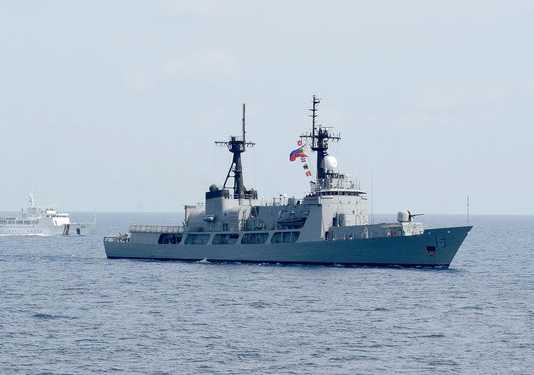In a Landmark moment for India’s defence industry, India’s state-run Garden Reach Shipbuilders & Engineers (GRSE) Ltd has emerged as the winner for Philippine Navy’s “naval modernization program”. GRSE was the lowest bidder to supply two light Kamorta Class frigates and hopes to seal the contract worth more than $321 million in the next two months, said one GRSE official. A total of four firms joined the bidding for the Philippine Navy project: GRSE (Indian); Hyundai Heavy Industries Inc. (South Korean) and Daewoo Shipbuilding & Marine Engineering Co. Ltd. (South Korean), and Navantia S.A. of Spain.
The light frigate offered to the Philippines will be a derivative of the GRSE’s Kamorta class frigate designed & developed for the Indian navy.
The Kamorta class offers the following advantages to the Philippine Navy (PN)
- Combined Diesel and Diesel (CODAD) propulsion for quiet and efficient running of the ship
- X-form hull with sloped superstructure sides which reduce radar cross-section and make it very stealthy.
- Raft mounted gearbox and engines, which damp the vibrations and reduce the acoustic signature of the ship. This is important to remain undetected from hostile submarines.
- Advanced radars & sonars
- Long endurance combatant, giving it the ability to conduct blue water operations
- Instead of sending a larger ship just to shadow an enemy submarine, a Kamorta class frigate does the same job more economically.
DESIGN
The 2 new frigates will be the first time the Philippine Navy (PN) will be purchasing brand new major surface combatants in its history. As of today, all the major combat assets are ex-US Navy/Coast Guard or Royal Navy excess defence articles. GRSE will not only provide brand new ships for the Philippine Navy but will also build them according to the specifications & requirements. This will be a big leap since most of Philippine Naval fleet is tailor made according to the specifications and requirements of donor countries, mainly the United States and Great Britain. This project will one be one of the most expensive defence project for the Philippine government.
The Kamorta class has been designed for the sole purpose of hunting submarines. It has a displacement of 3400 tons, a length of 109 m and a beam of 13 m. These dimensions are comparable to that of a frigate as the Kamorta Class has been designed for blue water ops as well. The Kamorta is touted by the Indian Navy as having over 90% indigenous content. The steel and composites which have been used in construction are indigenously made along with a majority of the weapons and sensors. It is powered by 4 Pielstick diesel engines generating 3888 kW each, which drive 2 controllable pitch propellers via the gearboxes. Each ship has a crew of 150 sailors and 15 officers and a very ergonomic design which focuses on crew comfort.
WEAPONS
- 1 x 76 mmOto Melara Super Rapid Gun Mount (SRGM) for engaging surface and aerial threats up to 16 km away.
- 2 x RBU-6000 ASW rocket launchers designated as IRL (Indigenous Rocket Launchers). Each launcher is 12 barreled and has a reload of 96 rockets under the deck. They are retained because of their hardkill ability and immunity against countermeasures. These rockets have a range of 4500 m and a shaped charge warhead which can be set to explode at a particular depth. It can punch a hole in the hull of a submarine or be used to defend against an incoming torpedo. The rocket, after it is fired, reaches the required location and falls in the water where it sinks until it reaches its target. Usually, 24 rockets with various warheads are ripple fired against the incoming target to achieve maximum kill rate.
- 2 x Ak 630 Gatling guns are placed above the helicopter hangar. They are the Close in Weapons System (CIWS) and are used for last-ditch defense against anti-ship missiles. This 30 mm 6-barreled gun has a rate of fire of 5000 rounds per minute and can be used to engage aerial targets at a range of 3 km and surface targets at 4 km.
- 533 mm torpedo tubes for launching heavyweight torpedoes. These have a maximum engagement range of around 20 km.
- Space left for the installation of 16/32 VL-Mica Surface to Air Missiles. They will be procured under the category of SR-SAM and locally named as Maitri.
- 1 helicopter hangar for housing an ASW helicopter. The S-70B Seahawk will be embarked on it in the future after the Indian Navy receives it. This will be an extremely vital weapon system as the helicopter can engage submarines several hundred kilometers form the ship.
There is a widespread misconception that the Kamorta is poorly armed for a 3400 ton ship. But it is very wrong to look at things like that at face value without understanding the logic and naval doctrine for behind them. The Indian Navy needed a ship which has the armament of a 1200 ton corvette and the endurance of a 3400 ton frigate. Basically, it is not under-armed, but over-sized. By 2017, it is expected to receive its SAM package consisting of 16-32 VL-Mica missiles which have a range of 15 km and an active seeker. This missile can intercept sea-skimming and supersonic cruise missiles and protect the Kamorta class from submarine launched cruise missiles. By having the endurance of a 3400 ton ship, Kamorta class will be able to conduct blue water operations something which its predecessor the Arnala class ASW corvettes, procured from the Soviet Union, couldn’t do.
The Kamorta would offer the following performance enhancements over the Arnala class.
- Thrice the displacement, resulting in more space for weapons and sensors
- Provision of hangar and helipad for an ASW helicopter
- Advanced radars and sonars
- Long endurance, enabling it to operate in blue water
- Ultra-quiet propulsion and engines
- High standard build quality
The Philippines consists of about 7,641 islands, therefore, the country needs warships which have long endurance and can guard the length and breadth of the entire archipelago. The GRSE frigate will complete this job effectively and economically. Needless to say, the Philippines has made the correct choice.
With inputs from:
https://defencyclopedia.com/2015/09/18/kamaurrta-class-sis-of-indias-deadly-anti-submarine-corvette/
































